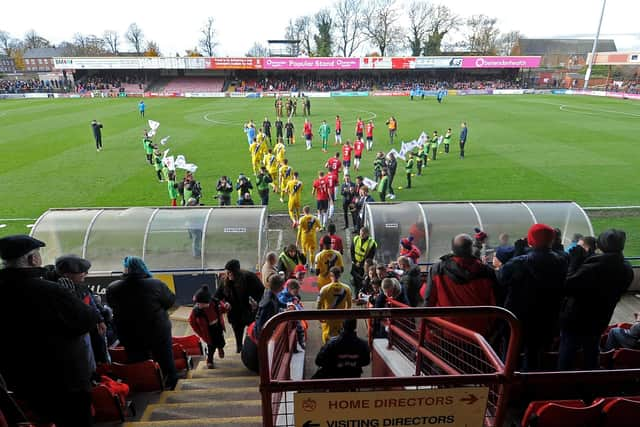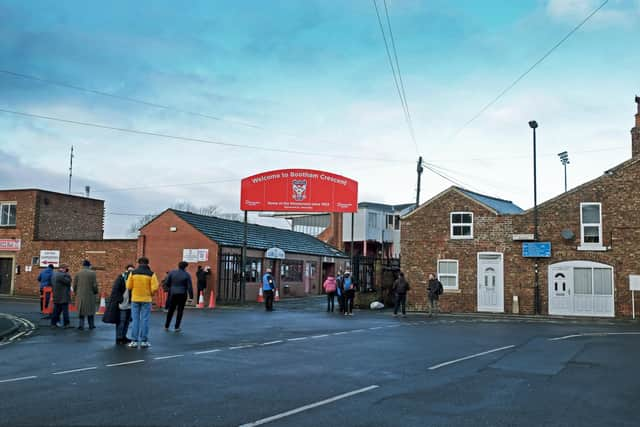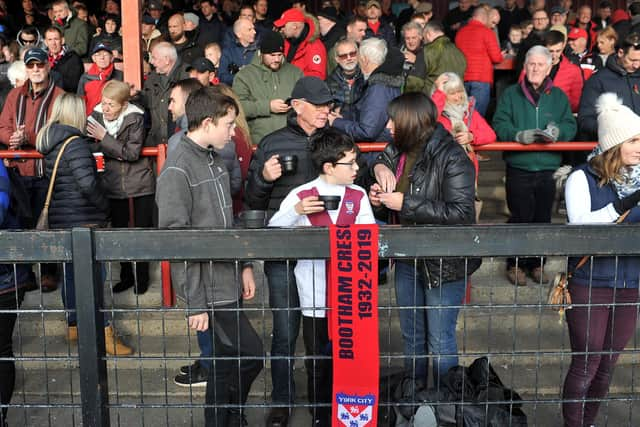Planned farewell to York City’s Bootham Crescent scuppered by Covid-19
Tonight was due to be the night York played at their home of 89 years for the final time, against Fylde in Conference North. Instead, a Covid-19 outbreak has not only seen the match postponed but also thrown their first game at the new LNER Community Stadium, pencilled in for next Tuesday’s visit of Gateshead, into doubt too.
York are awaiting National League guidance on the isolation period their players and staff will have to go through, but it is usually 10 days from the initial contact. The subsequent home match is not due to be until Curzon Ashton’s visit on the 30th.
Advertisement
Hide AdAdvertisement
Hide AdWith the January 2 game against Bradford (Park Avenue) postponed because of a frozen pitch, Bootham Crescent’s final game might have been a 1-0 win over Guiseley on December 28.


But even if the Bootham chapter of the club’s history is closed, for a long time York have been determined to ensure the venue for so many great memories does not disappear without trace, as their previous home has. There is no indication of the club’s original home but as the club’s stadium development director, one of Ian McAndrew’s jobs is ensuring Bootham Crescent lives on.
For York’s first 10 years they played at nearby Fulfordgate before moving into the home of York Cricket Club in 1932 – not that you would know it now.
“It will be slightly disappointing that because of Covid there’s not going to be the razzmatazz of leaving Bootham Crescent as we had proposed,” says McAndrew. “A long time ago we imagined fireworks leaving Bootham Crescent, a local band playing or whatever and everybody bouncing, then somebody cutting the tape in a new stadium and thinking, ‘Now we’re here.’
Advertisement
Hide AdAdvertisement
Hide Ad“That bit of excitement about it all has turned more into, ‘Let’s just get there, it’ll be great when we get in.’ We’re looking forward to it. The facilities are fantastic.”


When football grounds finally started to move on in the wake of the 1990 Taylor Report, Bootham largely stood still. That its hospitality boxes overlook a car park, not the pitch, highlight its obsolescence, and shows why chairman Jason McGill has spent the last 18 years working so hard to move the club to a new venue. They will share their new 8,500-seater stadium at Monks Cross with York City Knights rugby league team.
Bootham was no stranger to other sports – as well as rugby league, it hosted the York City Maroons baseball team in 1937 and 1938 after a successful 1934 exhibition game. In the summer of 1988 American football was played there and 30 years later it was even the set of Bollywood film Gold, mocked up as the Berlin Olympic Stadium in 1936.
Since 1932, though, football, has been its primary business, hosting the 2013 Women’s Premier League final and 2016 European Under-16 Championships as well as some famous FA Cup ties. It also has cultural significance to the city, all of which the Minstermen are now working to preserve.
Advertisement
Hide AdAdvertisement
Hide Ad“We’re hoping to retain part of the Popular Stand terracing in a memorial garden and a reference to what Bootham Crescent has done in terms of the culture and history of the city of York,” explains McAndrew.


“We’re 3D modelling the stands so we can hopefully give people the opportunity to see what the ground was like even after it has gone.
“We chose the Popular Stand because it’s on the back wall of the site and it’s got so much history having been used as an air raid shelter during World War Two. There will be flagpoles because of the old system of dropping the flag at five minutes before the end of the match. Some of the structure of the Pop Stand came from Fulfordgate, so there is a little bit of a connection.”
Some elements will move to the new ground, others will stay.
Advertisement
Hide AdAdvertisement
Hide Ad“The clock with the two lions at either side is going into the fanzone, it won’t be in the stadium because it’s got a new scoreboard and it’s not just about York City,” says McAndrew.


“We’ve had long discussions about what belongs to Bootham Crescent. We have five plaques – a commemoration of players who died in the Second World War – and that’s about the club so they are going with us.
“All the ashes and urns will be retained in a memorial area because they’re all about Bootham Crescent. We’ll be keeping some signage and some nice graffiti from 1998 saying ‘York City 2 Manchester City 1’. But the new stadium’s a fresh start. It isn’t going to be cluttered up with Bootham Crescent things.”
As with all football ground moves there has been opposition from supporters, as well as those with wider concerns, but most now seem reconciled to the fact it has to happen.
Advertisement
Hide AdAdvertisement
Hide Ad“In any other sector apart from sports clubs, people just move for bigger and better facilities, don’t they?” says McAndrew, a retired chartered surveyor. “If you lose a pub in a village, I suppose that’s a bit different but there are very few other areas where you have the same emotional upheaval.
“I think fans fall into the new stadium really quickly. Part of the work we are doing is to ensure you can still go back to Bootham Crescent and another generation will be able to take their kids and say, ‘Do you know your granddad played here?’ or went there every week.”
Support The Yorkshire Post and become a subscriber today. Your subscription will help us to continue to bring quality news to the people of Yorkshire. In return, you’ll see fewer ads on site, get free access to our app and receive exclusive members-only offers. Click HERE to subscribe.
Comment Guidelines
National World encourages reader discussion on our stories. User feedback, insights and back-and-forth exchanges add a rich layer of context to reporting. Please review our Community Guidelines before commenting.